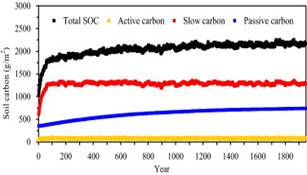Large-scale reclamation of arid land in Northwestern China over the past 50 years has converted the natural desert landscape into anthropogenic oasis, particularly in the lower part of watersheds. Drastic human activities may have caused the change in soil organic carbon (SOC) in anthropogenic oasis. Dr. Xu Wenqiang, Xinjiang Institute of Ecology and Geography, Chinese Academy of Sciences, employs the CENTURY model (Version 4.0) to investigate the effects of land reclamation and management practices in oasis agriculture on the dynamic of SOC at the lower part of Sangong River watershed, a typical anthropogenic oasis reclaimed before 50 years. Based on field investigation, history of crop rotations, and past farm practices in study area, land management practices were divided into five categories, corresponding five periods, before 1959 (un-reclaimed), 1959–1984, 1985–1992, 1993–1998 and 1999–2008.
The model successfully simulated the SOC dynamics of the top layer soil (0–20 cm) in the different periods. The state of equilibrium of total SOC and the active, slow, and passive carbon pools were built by CENTURY model before 1959. Over the 50 years’ cultivation (1959–2008), the mean change in total SOC exhibited complex ways. SOC increased rapidly in the first 2 years (1959–1960) after shrubland clearing, and declined slowly during the period 1961–1984 and then decreased rapidly from 1985 to 1992. Between 1993 and 1998, it remained relatively stable, and climbed rapidly again during 1999–2008. The trend in total SOC showed “N” shape, i.e., increase, decrease, then increase. Finally, total SOC is greater (8.2%) in 2008 than that at an original level of SOC under the natural desert shrub. The improvements of land management practices such as ploughing being replaced with no tillage, straw being crushed before returning it to soil, and reasonable application of fertilizers, played a key role in the change in total SOC. Especially, soil carbon sequestration was obviously increased since protective management practices were implemented in 1993, such as no tillage, straw returning to soil, and the balanced fertilization technique. The results were different from the conclusions that loss of soil organic carbon would happen due to reclamation and continuous farming in tropical forests, semiarid grasslands of Northern China and Nigerian semiarid Savannah.
The result was published in Ecological Complexity, 2011, 8(1): 30–37. doi: 10.1018/j.ecocom.2010.11.003.

Fig. 2 The original landscape before land reclamation. Photo a and b were natural desert landscape around Fubei Farm dominated by Tamarix ramosissima and Haloxylon ammodendron, respectively.

Fig. 3 The carbon pools change during the process of establishing equilibrium state using CENTURY model
